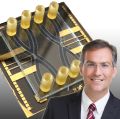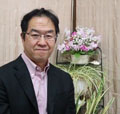 |
Emerging Memory: From Technology to Applications
Dave Egglestone
GLOBALFOUNDRIES, Santa Clara, CA, USA
A once-in-a-generation shift in low power computing architecture is on the horizon, with the commercialization of new memory technologies. These emerging memories (MRAM, RRAM, PCRAM, 3D Xpoint) have been long awaited, because of their promise of an ideal combination of speed, endurance, persistence and energy efficiency.
The speaker will lead the audience though a detailed analysis of emerging embedded memories, and their application in systems. The speaker will specifically focus on the promise, versatility, and nano-fabrication demands of eMRAM technology. Finally, the speaker will discuss how GLOBALFOUNDRIES is well positioned for SOC designers to capitalize on these future opportunities. |
 |
Chips-in-Organs & Organs-on-a-Chip
Peter Ertl
Vienna University of Technology, Faculty of Chemistry, Austria
The application of biochip technology for medical research has the potential of generating new diagnostic tools to help improve our understanding of the functioning of the human body. The global trend towards more evidence-based medicine, closed-meshed clinical diagnostic strategies and personalized therapies has therefore pushed the development of advanced in vivo and in vitro microsystems including implantable biosensors and organ-on-a-chip technology. For instance, an important strategy of medical therapies involves repeated follow-up examination using a variety of in vivo imaging technologies and in vitro assessment of biopsies. In the presentation novel approaches and technologies are introduced that are expected to provide a deeper understanding of in vivo bone regeneration and organ transplant rejection processes using implantable titanium dioxide-coated bioimpedance sensors. Additionally, three organ-on-a-chip systems are presented with the aim of studying the biological aspects of (i) the placenta barrier integrity under high blood pressure conditions, (ii) inflammatory reactions at the joing during rheumatic arthritis and (iii) neural degeneration rates in the midbrain to monitor the onset and progression Parkinson’s diseases. |
 |
Nanoimprint System Development and Status for High Volume Semiconductor Manufacturing
Takehiko Iwanaga
Canon Inc., Japan
Jet and Flash Imprint Lithography (J-FIL) has been in development for the past decade to meet the several requirements for semiconductor manufacturing. The purpose of this presentation is to describe the technology advancements made and introduce the new imprint systems that will be applied for the fabrication of advanced devices such as NAND Flash memory and DRAM. In particular, we will announce a cluster tool designed to meet both the technical and cost of ownership requirements of semiconductor manufacturing. Finally, we will show Canon’s overlay roadmap as well as new technologies designed to address higher order distortions. |
 |
Carbon-based Materials as Key-Enabler for “More-than-Moore“ Devices
Franz Kreupl
Technical University Munich, Faculty of Electrical Engineering and Information Technology, Department of Hybrid Electronic Systems, Munich, Germany
The talk will assess carbon-based materials like nanotubes and graphene in possible “More-than-Moore” applications. The requirements for the use in future transistor devices and interconnects is reviewed and the discussion is extended to applications which are not ultimately scaled to the smallest size. We show the application of graphenic carbon, which requires a high temperature budget for the deposition, in capacitors, diodes, through-silicon vias, novel non-volatile memories and sensors. The use of graphenic carbon as a hermitically tight x-ray transmission window is facilitated by its high mechanical resilience and has been demonstrated recently for the first time. |
|
Self-Powered Health and Environmental Monitoring for Wellness
Veena Misra
NSF ASSIST Nanosystems Center and Department of Electrical Engineering, North Carolina State University, Raleigh, NC
Self-powered wearable sensor systems can enable long-term sensing and effective management of chronic conditions, sensing of personal exposure to air pollutants and toxins and provide longitudinal studies that can provide new insight into correlation of various health and environmental parameters. Such sensor systems can empower patients and providers to manage wellness instead of managing illness, assist in effective treatment of at-risk elderly, reinforce healthy lifestyles, and provide new tools for long-term environmental exposure health studies. Recent advances in nanomaterials, nanostructures, and nanodevices have increased efficiency of energy harvesters, lowered energy per computational bit, increased capacitor storage density, and enhanced nanosensor efficiency making a self-powered system finally realizable. I will discuss the challenges in technology development, including energy harvesting, ultra low power radios and durability, needed to realize these sensor systems and explore the role that data will play in making these systems effective for both the patient and the provider. |
 |
Micro Electro Mechanical Systems — Technology and Applications
Nico de Rooij
Prof. em., Institute of Microengineering, EPFL, Neuchatel, and Vice-President at CSEM SA, Switzerland
The continuous progress in micro- and nanofabrication technologies for the manufacturing of Micro Electro Mechanical Systems or MEMS has allowed the successful development of many innovative products used in our daily life. In this paper an overview will be given of various micro- and nanofabrication process technologies, including Deep Reactive Ion Etching (DRIE), thick photo resist processing and plating. The possibilities and limits of these selected fabrication processes will be illustrated with examples of MEMS including their applications. |
|
Gel-technology in microfluidics and biochips
Michiel Vellekoop
Institute for Microsensors, -Actuators and -Systems, IMSAS, University of Bremen, Germany
In recent years, polymeric hydrogels have gained major interest for application in microfluidics devices and biochips. The availability of a range of gels and the structuring possibilities of it on the micro-level make it an attractive material for the realization of new on-chip functions such as mechanical filters, diffusive barriers, biochemical reactors, or cell biosensors. In the presentation, an introduction to the topic, general aspects of fabrication technologies, and illustrative examples will be discussed. |